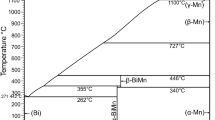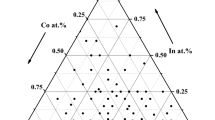Abstract
X-ray diffraction has been applied to the component interaction study in the ternary Tm ― Mn ― B system, and the 1070 K isothermal section of the phase diagram has been constructed. The ternary boride TmMnB4 is confirmed as present, which has the YCrB4 structure type (space group Pbam, a = 0.5868-0.5894 nm; b = 1.1320-1.1370 nm; c = 0.3368-0.34018 nm). The lattice parameter variation indicates that the ternary boride has only a narrow homogeneity region, which is in the direction of higher manganese contents. There are no solid solutions based on binary compounds in the Tm ― Mn ― B system.
Similar content being viewed by others
References
Yu. B. Kuz'ma and N. F. Chaban, Binary and Ternary Systems Containing Boron [in Russian], Metallurgiya, Moscow (1990).
S. I. Mikhalenko, N. F. Chaban, and Yu. B. Kuz'ma, “Interactions in the Ln — Mn — B systems (Ln = Dy, Ho, Er),” Neorgan. Materialy, 27, No. 11, 2298–2302 (1991).
N. F. Chaban, S. I. Mikhalenko, and Yu. B. Kuz'ma, “New compounds with structures of YcrB4 type,” Neorgan. Materialy, 32, No. 1, 44–48 (1996).
Yu. B. Kuz'ma, Boride Crystallochemistry [in Russian], Vishcha Shk., L'vov (1983).
L.-E. Tergenius, “Refinement of the crystal structure of orthorhombic Mn2B (formerly denoted Mn4B),” J. Less-Common Met., 62, Nos. 1–2, 335–340 (1981).
K. E. Spear, Rare Earth-Boron Phase Equilibria: Boron and Refractory Borides, Springer-Verlag, Berlin (1977), pp. 439–456.
M. E. Schlesinger, “The lesser-known B — Ln (boron — lanthanide) systems: B — Dy (boron — dysprosium), B — Ho (boron — holmium), B — Lu (boron — lutetium), B — Pr (boron — praseodymium), B — Tm (boron — thulium), and B — Yb (boron — ytterbium),” J. Phase Equilibria, 19, 49–55 (1998).
P. Villars, Pearsson's Handbook Desk Edition: Crystallographic Data for Intermetallic Phases, Vols. 1, 2, Metals Park (1997).
L. G. Akselrud, Yu. Grin, P. Yu. Zavalij, et al., “CSD — Universal program package for single crystal and powder data treatment,” Collected Abstracts of XII Europ. Crystallographic Meet (Moscow, August 22–29, 1989), Vol. 3, USSR Academy of Sciences, Moscow (1989), p. 155.
N. Wiberg, Lehrbuch der Anorganischen Chemie, Walter de Gruyter, Berlin (1995), pp. 1834–1841.
Author information
Authors and Affiliations
Rights and permissions
About this article
Cite this article
Kuz'ma, Y.B. The Equilibrium Phase Diagram for the Tm ― Mn ― B System. Powder Metallurgy and Metal Ceramics 40, 258–261 (2001). https://doi.org/10.1023/A:1012801415410
Issue Date:
DOI: https://doi.org/10.1023/A:1012801415410




